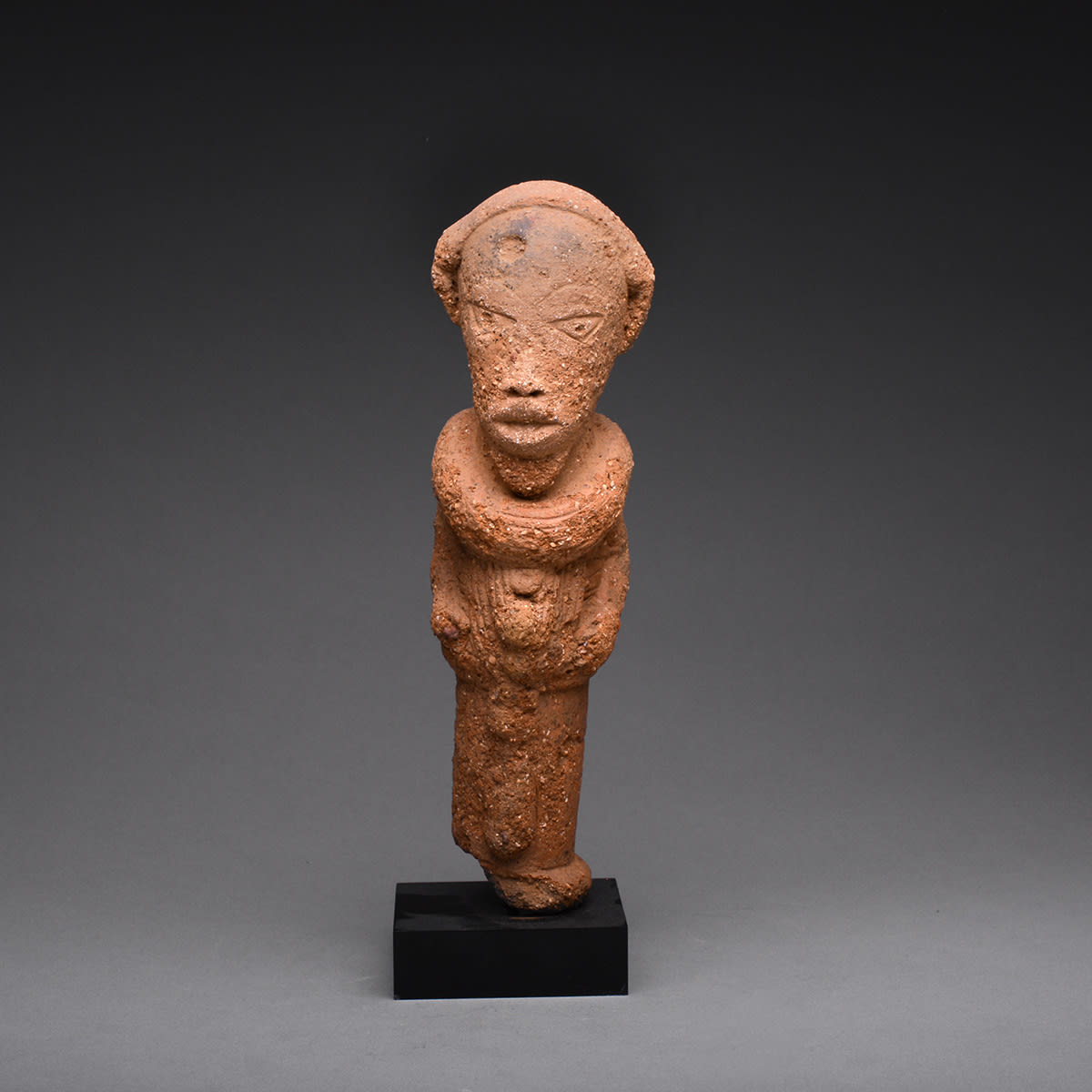Nok Terracotta Standing Man, 500 BCE - 200 CE
Terracotta
24.8 x 6.3 cm
9 3/4 x 2 1/2 in
9 3/4 x 2 1/2 in
MT.5
Further images
A Chieftain or King of great importance in costume of rank and ornately decorated and bejeweled. Standing with a great command for respect. As exemplified here, the head of Nok...
A Chieftain or King of great importance in costume of rank and ornately decorated and bejeweled. Standing with a great command for respect. As exemplified here, the head of Nok terracottas are invariably proportionally large relative to the body, and while not enough is known of Nok culture to explain this apparent imbalance, it is interesting to note that a similar emphasis of the head in later African art traditions often signifies respect for intelligence. Unlike most examples, this special Nok sculpture is solid. As is quite common, the slip has eroded, leaving a grainy, pocked exterior that does not reflect its original smooth appearance.
These objects are so highly varied that it is likely this was modeled individually perhaps after an important model. Every Nok head is unique, but this piece also enjoys certain stylistic traits of the genre. Triangular eyes and perforated pupils, characteristic noble beard, flared nose and mouth precisely and exquisitely animated in formation ready to proclaim judgment and share its ancient wisdom. The depiction is a honorary with bold, abstracted features. But perhaps the most striking aspect of this sculpture is the elaborately detailed headdress, costume and jewelry that adorns the awesome figure. The variety, inventiveness, and beauty of Nok design is a beguiling record of cultivated devotion to body ornamentation. In 1943, tin mining in the vicinity of the village of Nok near the Jos Plateau region of Nigeria brought to light a terracotta head, evidence of the oldest known figurative sculpture south of the Sahara. Although stylistically related heads, figures, animals, and pottery shards have been found in a number of Nigerian sites since that time, such works are identified by the name of the small village where the first terracotta head was discovered. Artifacts continue to be unearthed without documentation of the context in which they were buried, a lack of extensive archaeological study that has severely limited our understanding of Nok terracottas. One of the earliest African centers of ironworking and terracotta figure production, the Nok culture remains an enigma. The meaning and function of this and similar images can only be speculated. They must have represented rulers, ancestors, or deities. In contrast, Nok figures with physical deformities might have been used in healing rituals. Certain figures may have served as roof finials to mark houses containing shrines or sacred objects, as is the custom in some areas of West Africa today. The great sophistication of Nok terracottas has led some scholars to believe that an older, as yet undiscovered tradition must have preceded Nok terracotta arts. Masterful relics severed from their predecessors and successors by the passage of time, Nok terracottas currently occupy an important but isolated space in the history of African art.
These objects are so highly varied that it is likely this was modeled individually perhaps after an important model. Every Nok head is unique, but this piece also enjoys certain stylistic traits of the genre. Triangular eyes and perforated pupils, characteristic noble beard, flared nose and mouth precisely and exquisitely animated in formation ready to proclaim judgment and share its ancient wisdom. The depiction is a honorary with bold, abstracted features. But perhaps the most striking aspect of this sculpture is the elaborately detailed headdress, costume and jewelry that adorns the awesome figure. The variety, inventiveness, and beauty of Nok design is a beguiling record of cultivated devotion to body ornamentation. In 1943, tin mining in the vicinity of the village of Nok near the Jos Plateau region of Nigeria brought to light a terracotta head, evidence of the oldest known figurative sculpture south of the Sahara. Although stylistically related heads, figures, animals, and pottery shards have been found in a number of Nigerian sites since that time, such works are identified by the name of the small village where the first terracotta head was discovered. Artifacts continue to be unearthed without documentation of the context in which they were buried, a lack of extensive archaeological study that has severely limited our understanding of Nok terracottas. One of the earliest African centers of ironworking and terracotta figure production, the Nok culture remains an enigma. The meaning and function of this and similar images can only be speculated. They must have represented rulers, ancestors, or deities. In contrast, Nok figures with physical deformities might have been used in healing rituals. Certain figures may have served as roof finials to mark houses containing shrines or sacred objects, as is the custom in some areas of West Africa today. The great sophistication of Nok terracottas has led some scholars to believe that an older, as yet undiscovered tradition must have preceded Nok terracotta arts. Masterful relics severed from their predecessors and successors by the passage of time, Nok terracottas currently occupy an important but isolated space in the history of African art.







